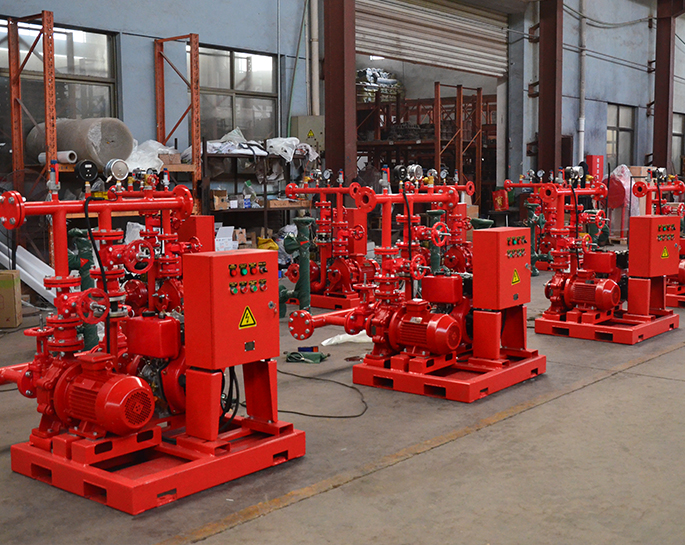How are fire pump suction and discharge pressures balanced in multi-pump systems?
Jan 08, 2024
Share:
In multi-pump fire protection systems, balancing suction and discharge pressures is crucial to ensure proper pump operation and system performance. The goal is to distribute the flow evenly among the pumps and maintain consistent pressure throughout the system. Here are some common methods used to balance suction and discharge pressures in multi-pump systems:
1. **Variable Speed Drives (VSDs):**
- VSDs can be employed to control the speed of each pump motor independently. By adjusting the speed of the pumps, you can fine-tune the flow rate and maintain balanced pressures. Modern fire pump controllers often use VSD technology for this purpose.
2. **Pressure-Reducing Valves:**
- Pressure-reducing valves can be installed on the discharge side of each pump. These valves regulate the pressure and help maintain a consistent discharge pressure by throttling the flow as needed. However, excessive use of pressure-reducing valves can lead to energy inefficiency.
3. **Parallel Operation with Check Valves:**
- Multiple pumps can be operated in parallel with check valves on the discharge side of each pump. Check valves prevent reverse flow when a pump is not in operation. The pumps start and stop based on the system demand, and the check valves maintain pressure integrity in the system.
4. **Staging:**
- Staging involves bringing pumps online sequentially based on system demand. Smaller pumps may operate during periods of low demand, with larger pumps activating as demand increases. This helps in maintaining efficient operation and balanced pressures.
5. **Pressure Sensing and Control Systems:**
- Advanced pressure sensing and control systems can monitor the pressure at various points in the system. These systems can then adjust pump speeds or activate/deactivate pumps as needed to maintain balanced pressures.
6. **Bypass Lines with Control Valves:**
- Bypass lines equipped with control valves can be used to redirect excess flow back to the suction side of the pumps. By adjusting the control valves, you can manage the flow distribution and balance pressures.
7. **System Design:**
- Proper system design, including pipe sizing and layout, plays a crucial role in balancing pressures. A well-designed system minimizes friction losses and ensures uniform flow distribution among the pumps.
It's essential to consult with a qualified fire protection engineer or specialist when designing and implementing a multi-pump fire protection system. The specific method chosen may depend on factors such as the system layout, pump types, and regulatory requirements. Regular maintenance and monitoring are also important to ensure that the system continues to operate effectively over time.

1. **Variable Speed Drives (VSDs):**
- VSDs can be employed to control the speed of each pump motor independently. By adjusting the speed of the pumps, you can fine-tune the flow rate and maintain balanced pressures. Modern fire pump controllers often use VSD technology for this purpose.
2. **Pressure-Reducing Valves:**
- Pressure-reducing valves can be installed on the discharge side of each pump. These valves regulate the pressure and help maintain a consistent discharge pressure by throttling the flow as needed. However, excessive use of pressure-reducing valves can lead to energy inefficiency.
3. **Parallel Operation with Check Valves:**
- Multiple pumps can be operated in parallel with check valves on the discharge side of each pump. Check valves prevent reverse flow when a pump is not in operation. The pumps start and stop based on the system demand, and the check valves maintain pressure integrity in the system.
4. **Staging:**
- Staging involves bringing pumps online sequentially based on system demand. Smaller pumps may operate during periods of low demand, with larger pumps activating as demand increases. This helps in maintaining efficient operation and balanced pressures.
5. **Pressure Sensing and Control Systems:**
- Advanced pressure sensing and control systems can monitor the pressure at various points in the system. These systems can then adjust pump speeds or activate/deactivate pumps as needed to maintain balanced pressures.
6. **Bypass Lines with Control Valves:**
- Bypass lines equipped with control valves can be used to redirect excess flow back to the suction side of the pumps. By adjusting the control valves, you can manage the flow distribution and balance pressures.
7. **System Design:**
- Proper system design, including pipe sizing and layout, plays a crucial role in balancing pressures. A well-designed system minimizes friction losses and ensures uniform flow distribution among the pumps.
It's essential to consult with a qualified fire protection engineer or specialist when designing and implementing a multi-pump fire protection system. The specific method chosen may depend on factors such as the system layout, pump types, and regulatory requirements. Regular maintenance and monitoring are also important to ensure that the system continues to operate effectively over time.







